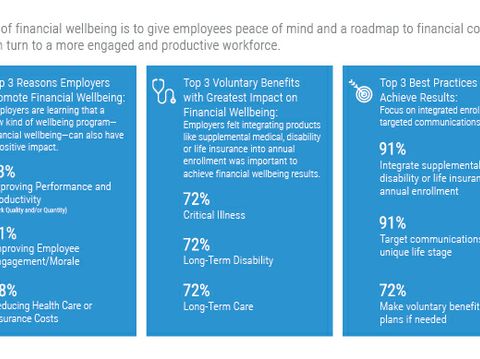


While stress does not always stem from work, it often filters into the workplace. Employers today recognize this and see voluntary benefits as a way to ease the impact financial stress has on employee wellbeing and performance.
The inaugural 2016 Xerox HR Services Financial Wellbeing & Voluntary Benefits Survey found that two-thirds of companies are integrating more voluntary benefits to supplement core benefits packages to promote financial wellbeing.
Voluntary benefits traditionally have been non-core offerings paid either partially or entirely by the employee. Employers are now bringing these voluntary benefits into their core offerings, provided with the employer’s open enrollment options. Today’s most common examples include critical illness, accident and hospital indemnity.
“Our study shows 78 percent of employers view voluntary benefits as being extremely effective or very effective in supporting employee financial wellbeing, giving them peace of mind and a roadmap to financial control,” said Tom Kelly, principal, Xerox HR Services and co-author of the survey.
Survey responses show 55 percent of companies are either working on implementing financial wellbeing strategies, or plan to within the next three years, while 38 percent have a program already in place. The most popular strategies include financial health assessments, workshops, education materials and retirement planning calculators.
According to this inaugural survey, the top objective for integrating voluntary benefits with core benefits is addressing financial stress that ultimately leads to health issues and higher benefit costs. Other often cited reasons include:
Past Xerox research has shown that more than a third of global companies rate their organizational stress levels “high or very high” and 87 percent see employee performance as the most important reason to address work-related stress and poor mental wellbeing.
“Many employees are becoming increasingly stressed about their finances – whether it’s planning for unexpected expenses or readying for retirement,” said Kelly. “It’s safe to say finances are a major concern for the modern-day workforce and employers can help alleviate the entire gamut of stress by providing a more robust voluntary benefits package that addresses an employee’s overall wellbeing.”
Xerox HR Services helps employers improve their HR programs through advisory, technology, and administrative services while enabling employees to better manage their health and wealth programs as well as their career development.
About the Survey
The Xerox HR Services Financial Wellbeing & Voluntary Benefits Survey was completed via an online questionnaire of more than 500 benefit decision-makers from large employers (more than 1,000 employees), fielded between March 11 and March 25, 2016. The data represents the actual practices of participants and the full results are available at no cost to the media by contacting David Joslin at David.Joslin@xerox.com or +1-585-754-2978.
About Xerox
Xerox is helping change the way the world works. By applying our expertise in imaging, business process, analytics, automation and user-centric insights, we engineer the flow of work to provide greater productivity, efficiency and personalization. Our employees create meaningful innovations and provide business process services, printing equipment, software and solutions that make a real difference for our clients and their customers in 180 countries. On January 29, 2016, Xerox announced its plans to separate into two independent, publicly traded companies – Xerox Corporation, which will be comprised of the company’s Document Technology and Document Outsourcing businesses, and Conduent Incorporated, a business process services company. The company is on track to complete the separation by the end of 2016.
-XXX-